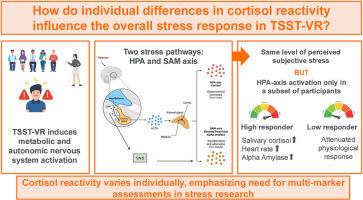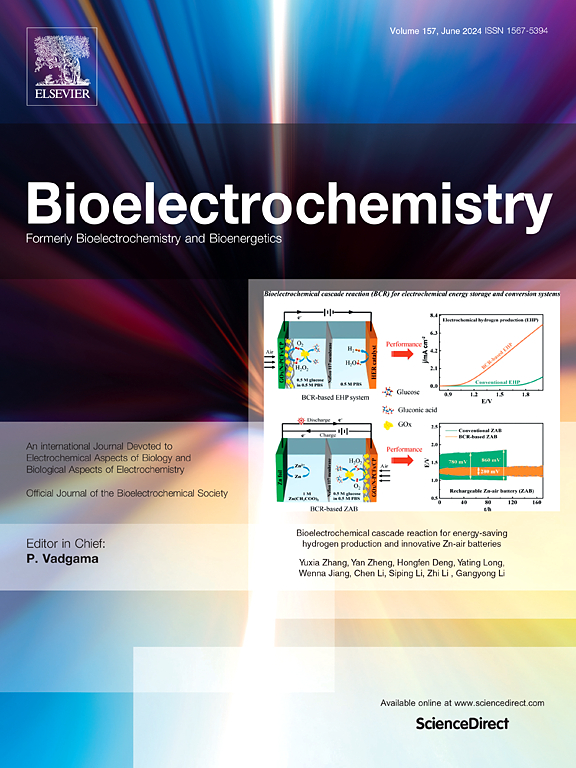Virtual stress testing: Analyzing endocrine, metabolic, cardiovascular, and psychological responses to the TSST-VR
IF 3.6
2区 医学
Q1 NEUROSCIENCES
引用次数: 0
Abstract
Background
The Trier Social Stress Test (TSST) is a widely used tool for inducing and measuring stress responses in a controlled environment. In this study, we aimed to explore the effectiveness of a virtual TSST (TSST-VR) in eliciting stress responses across multiple physiological and psychological markers.
Methods
A sample of 24 participants underwent the TSST-VR, during which salivary cortisol, alpha-amylase (AA), blood glucose levels, heart rate (HR), root mean square of successive differences (RMSSD) as a measure of heart rate variability (HRV), and subjective stress ratings (NRS) were collected at multiple time points.
Results
In a baseline-to-peak analysis, significant increases were observed in HR (MDiff = 13.04, 95 %-CI [8.19–17.90], p < .001), RMSSD (MDiff = 17.75, 95 %-CI [3.28–32.22], p < .001), AA (p < .001, r = 1.07), and NRS (p < .001, r = 1.31) measures following the TSST-VR. While no significant changes in cortisol levels were found in the baseline-to-peak analysis across all participants, a secondary cluster analysis identified distinct cortisol responders (baseline-to-peak rise >1.5 mmol/l). Within this group, high cortisol responders (HCR) showed significantly higher cortisol (Wald χ2(7) = 118.03, p < .001), HR (Wald χ2(8) = 17.91, p = .022), and AA levels (Wald χ2(7) = 17.13, p = .017) compared to low cortisol responders (LCR). Area-under-the-curve analysis further confirmed a more robust cortisol stress response in HCR.
Conclusion
These findings suggest that the TSST-VR can effectively induce measurable stress responses and may provide insights into individual differences in physiological and metabolic stress reactions. The study highlights the potential of virtual stress paradigms in stress research and underscores the advantages of a virtual setting in terms of standardization and economic considerations.

虚拟压力测试:分析内分泌、代谢、心血管和心理对TSST-VR的反应
Trier社会压力测试(TSST)是一种在受控环境中诱导和测量压力反应的广泛使用的工具。在这项研究中,我们的目的是探讨虚拟TSST (TSST- vr)在多种生理和心理标记中引发应激反应的有效性。方法对24名参与者进行TSST-VR,在此期间,在多个时间点收集唾液皮质醇、α -淀粉酶(AA)、血糖水平、心率(HR)、连续差异均方根(RMSSD)作为心率变异性(HRV)的测量指标,以及主观应激评分(NRS)。结果基线-峰值分析显示,TSST-VR后患者的HR (MDiff = 13.04, 95% -CI [8.19-17.90], p < 0.001)、RMSSD (MDiff = 17.75, 95% -CI [3.28-32.22], p < 0.001)、AA (p < 0.001, r = 1.07)和NRS (p < 0.001, r = 1.31)指标均显著升高。虽然在所有参与者的基线-峰值分析中没有发现皮质醇水平的显著变化,但二次聚类分析确定了不同的皮质醇应答者(基线-峰值升高>;1.5 mmol/l)。在该组中,高皮质醇应答者(HCR)的皮质醇(Wald χ2(7) = 118.03, p < 0.001)、HR (Wald χ2(8) = 17.91, p = 0.022)和AA水平(Wald χ2(7) = 17.13, p = 0.017)均显著高于低皮质醇应答者(LCR)。曲线下面积分析进一步证实了HCR中更强的皮质醇应激反应。结论TSST-VR可有效诱导可测量的应激反应,为揭示生理和代谢应激反应的个体差异提供依据。该研究强调了虚拟应力范式在应力研究中的潜力,并强调了虚拟环境在标准化和经济考虑方面的优势。
本文章由计算机程序翻译,如有差异,请以英文原文为准。
求助全文
约1分钟内获得全文
求助全文
来源期刊

Neurobiology of Stress
Biochemistry, Genetics and Molecular Biology-Biochemistry
CiteScore
9.40
自引率
4.00%
发文量
74
审稿时长
48 days
期刊介绍:
Neurobiology of Stress is a multidisciplinary journal for the publication of original research and review articles on basic, translational and clinical research into stress and related disorders. It will focus on the impact of stress on the brain from cellular to behavioral functions and stress-related neuropsychiatric disorders (such as depression, trauma and anxiety). The translation of basic research findings into real-world applications will be a key aim of the journal.
Basic, translational and clinical research on the following topics as they relate to stress will be covered:
Molecular substrates and cell signaling,
Genetics and epigenetics,
Stress circuitry,
Structural and physiological plasticity,
Developmental Aspects,
Laboratory models of stress,
Neuroinflammation and pathology,
Memory and Cognition,
Motivational Processes,
Fear and Anxiety,
Stress-related neuropsychiatric disorders (including depression, PTSD, substance abuse),
Neuropsychopharmacology.
 求助内容:
求助内容: 应助结果提醒方式:
应助结果提醒方式:


